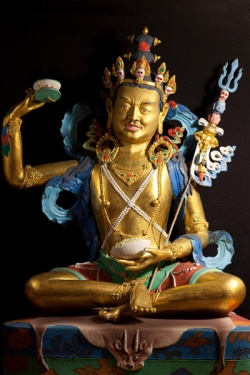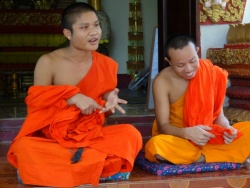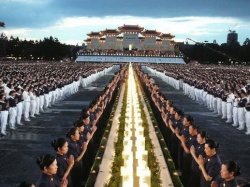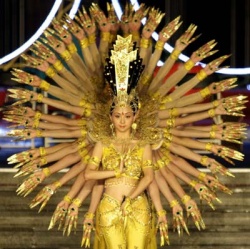The Legacy of Ch’an Master Xu Yun (1840-1959)
Empty Cloud Adrian Chan-Wyles, PhD 2013-07-17
Master Xu Yun had an extraordinary and very long life. He lived into his 120th year, and his life spanned two centuries and three dynasties. It is a belief within traditional Chinese culture that the purer the character, the longer the life that is lived. Master Xu Yun’s long life is attributed to his following of the Buddhist monastic vows including a vegetarian diet – and the fact that when young and still a layman, he refused an arranged marriage. More than this, however, but his father, fearing that his son would not follow in his footsteps and become a scholar-official, hired a Daoist master to teach Xu Yun the secrets of that religion. Xu Yun studied the Daoist teachings but did not agree with them – as he much preferred the Buddha’s teachings and yearned from an early age to seek further instruction in the Dharma, and to become a Buddhist monk.
He left home at the age of 19 and permanently turned his back on the world of delusion. Even as a monk, the world can present expected and unexpected temptations. When Xu Yun was 38 years old (1877/78), he was riding on a small boat travelling between Ningbo to Hangzhou. At night a young woman made advances toward the master, who in response sat-up in the meditation posture and started reciting a mantra. At that moment the woman could not move, and the situation did not progress any further. Through thick and thin master Xu Yun remained a monk for the next 101 years.
His life time witnessed tumultuous changes in the political and cultural life of China. He was born during the Qing Dynasty (1644-1911) and experienced the collapse of the imperial feudal system which had existed in China for over two thousand years. He saw the establishment of the short lived Republic of China (1912-1949) and the eventual victory of Mao Zedong’s Communist forces in 1949. In the New China, the strength of his character and the depth of his spiritual attainment helped Chinese Buddhism begin the transition into the modern age. Many good and fine masters, who were his disciples, such as Sheng Yi, Ti Guang, Ben Huan, Hai Deng, Yi Cheng, and Jing Hui, and many others, lived into recent times, and have kept the legacy of Chinese Ch’an Buddhism very much alive. This is because master Xu Yun almost single-handedly revived the Ch’an tradition, breathing a new and dynamic life into its various lineages. Indeed, master Xu Yun is viewed as being the rightful heir to all Ch’an lineages, and in so doing is considered the Right Dharma Eye for this Generation.
Xu Yun travelled (primarily on foot and by boat) extensively outside of China, to such countries as Tibet, Burma, Thailand, India, Singapore, (British) Hong Kong, and Sri Lanka. Although he never travelled to the West, he did meet a number of Westerners in China with an interest in Buddhism, including John Blofeld and Amanda Jennings. This situation was compounded by the fact that in 1931 (when Xu Yun was already 91 years old) the first recorded Westerner – Zhao Kong (i.e. Trebitsch Lincoln) – ordained at Nanjing as a Ch’an monk. Xu Yun was convinced through this interaction that the conditions existed in the West for the spread of Chinese Buddhism. The barrier preventing this transmission was a lack of access to Chinese Buddhist texts in European languages. He requested a lay disciple – Charles Luk (1898-1978) – to translate as many key Chinese Buddhist texts into reliable English as possible, adding an explanatory commentary of technical terms to each rendition. This process opened the spread of authentic Chinese Ch’an Buddhism to the West, which hitherto had only been exposed to Japanese Zen, and the Pali tradition associated with the Theravada School.
Like all great masters in the Chinese tradition, master Xu Yun was considered fully enlightened. The English translation of his biography entitled ‘Empty Cloud’ states that he attained enlightenment at the age of 56 years (in 1895/96), at the Gao Min Monastery at Yangzhou. Just prior to this event, he had fell into a river and floated with the current for a day and night. His body was battered, bruised and bleeding when he finally reached the gates of Gao Min. The abbot of Gao Min offered Xu Yun the seat of honour in leading the upcoming intensive meditation classes. Xu Yun declined but did not mention his previous accident and resultant ill health. As to decline such an honour was a violation of the rules of Gao Min, Xu Yun was beaten with a stick as punishment, throughout the entire process he did not complain or flinch in any way. As his body was suffering terribly from the accident and the subsequent punishment, Xu Yun sat resolutely within the meditation hall and did not move. He focused his mind day and night for 20 days, and then suddenly all illness and pain disappeared. At this time his thoughts were brought to an abrupt halt, and one evening, when he opened his eyes, he perceived a great bright light, and when he got up, his body seemed light, and his feet felt like they were treading on air. He could see through the wall and perceive all the activity both within and outside of the monastery. Weeks later boiling water was accidently splashed across his hand and he dropped a tea-cup that smashed on the floor with a loud sound. At that moment all doubts vanished and he clearly perceived the Mind Ground – the empty essence of Buddhist reality that contains all things.
He spent much of his life re-building and restoring temples and monasteries all over China. Without his direct influence, it is doubtful that Chinese Buddhism in general, and Ch’an inparticular, would have survived into the current age. He was a great master whose pure example stood out amongst many other good masters, who all worked together in various ways to keep the Buddha’s teaching alive. Occasionally he would demonstrate his use of qi force by withstanding illness, accident, ill treatment, and bad fortune. Whilst escorting a large Buddha statue from Burma to China, the workmen stopped halfway and refused to move without further payment. Master Xu Yun pointed at a very large boulder – which looked far heavier than the Buddha statue – and lifted it with ease. The workmen were astonished by this show of hidden strength and immediately got back to work. Another time, whilst living in a remote area, master Xu Yun entered the state of samadhi and sat there for weeks. When he returned, he found that the snow had spread into his hut, and there were tiger foot-prints walking all around him. Such was his spiritual power that during a drought in 1900, he carried-out a ritual over many days which caused snow to fall – at this time even the empress dowager bowed at his feet, referring to him as a living Buddha. Master Xu Yun always reminded everyone that animals and humans should live in harmony – to this end he once befriended a white fox that lived in the monastery at Nan Hua. When Xu Yun sat in meditation, the fox would sit on his mat with him. There are many more such stories regarding master Xu Yun.
As a result of his long life and good reputation, master Xu Yun is revered in China, and the Chinese diaspora, as well as becoming ever better known in the West through translated texts, and improved travel opportunities to China. Ch’an lineages have been established outside of China, and individuals and groups are able to receive Ch’an training in monasteries and temples on the mainland and elsewhere. The Chinese language internet contains thousands of pages dedicated to the memory of Xu Yun, set-up by devout lay individuals, monastics, and temples, and there is now ample biographical material entered in encyclopaedias. There are even rumours amongst Chinese Buddhists that master Xu Yun has been re-born and now lives quietly in the Chinese hills, keeping a watchful eye on the Dharma and its practice. His biography – originally compiled by the scholar Cen Xue Lu in the 1950’s – has undergone a number of revisions and extensions as more and more information has come to light, and has been gathered together. Indeed, his reputation has never waned, but has gone from strength to strength over the years. Through master Xu Yun’s spiritual power and wisdom, a wave of transmission of Chinese Buddhist teaching has emanated from China out into the world, and it is a movement that has gathered strength and does not look like stopping any time soon. Today, a new generation is able to read about master Xu Yun, and watch his life story on Chinese DVD. As time goes by, master Xu Yun’s influence appears to be stronger than ever. There are hundreds of photographs of this great master, and any one who looks at them will instantly understand why this is so.



